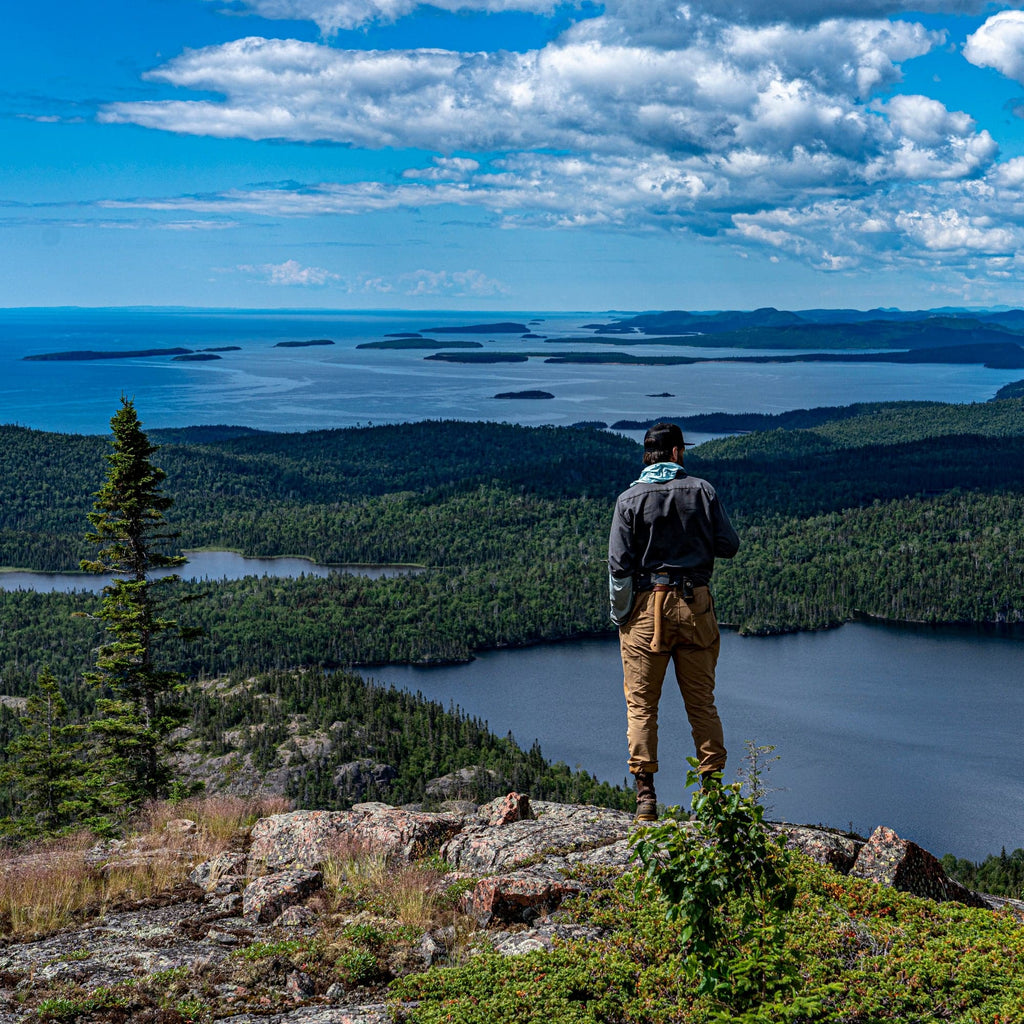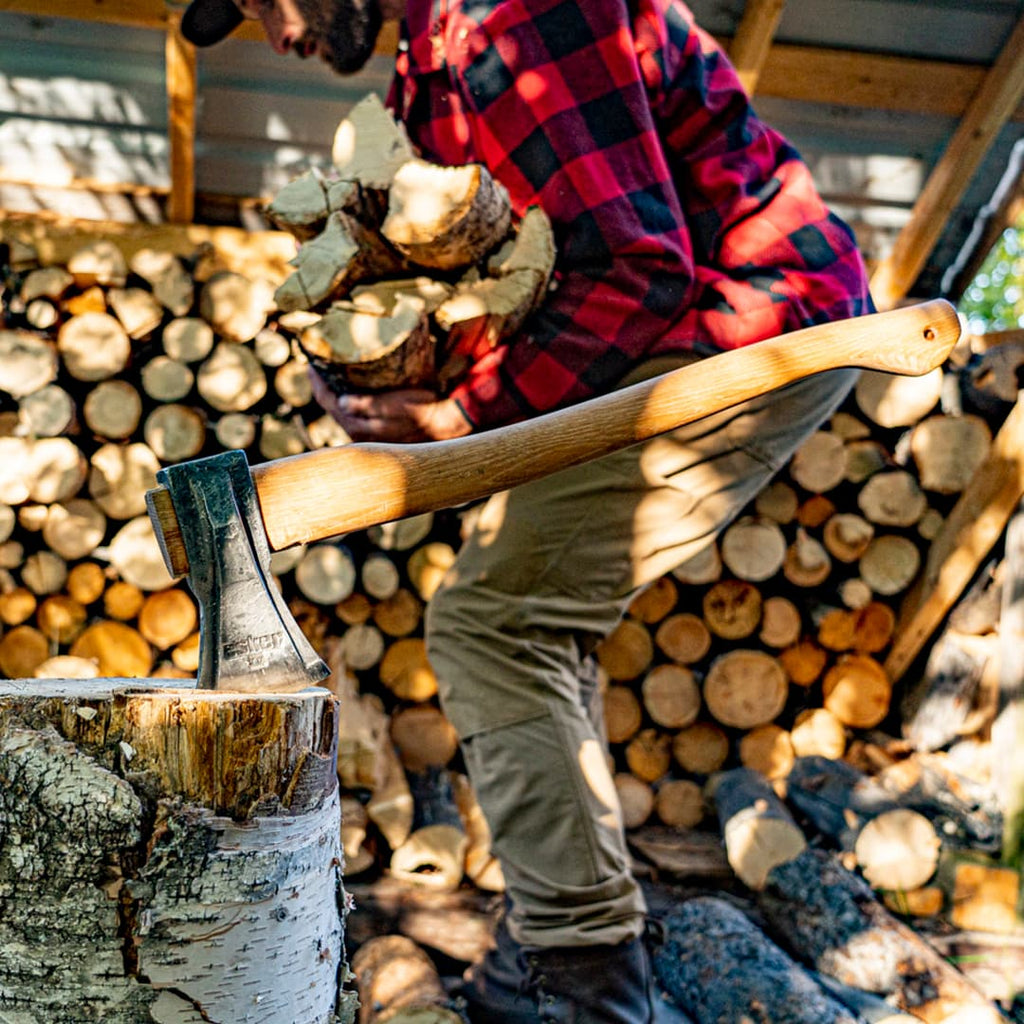Embracing the Wilderness by the light of a Cozy Campfire with Your Esker Camp Axe

We land our canoe at a likely campsite, the kind of bedrock outcropping that whispers to seasoned travellers—Northern Ontario’s rugged beauty. This spot, with its eastward face, promises a breathtaking sunrise, pristine swimming, and a perfect canvas for a comforting campfire. However, firewood is as elusive as it is essential, so we venture into the wild, seeking the promise of warmth and light that only a good fire can provide.

The Quest for Firewood
Our search leads us behind the camp, where nature’s challenges unfold. Here, amidst the dense undergrowth and the whispering Labrador tea, we discover our firewood—priceless yet cumbersome. The wood is too thick at the base to be easily sawn, presenting a challenge that only the right tool can overcome. That’s when we reach for our Esker Camp Axe.

Wading through the knee-high Labrador tea, I approach a dry-standing black spruce, its twisted limbs promising a blaze that will dance against the evening sky. With a deliberate motion, I pop the sheath off the Esker Camp Axe. The moment feels almost ceremonial, a prelude to the artistry of splitting wood.
The Art of Using Your Esker Camp Axe
As the first swing connects, a large, dry wood chip flies off, announcing the beginning of our work. Each swing of the Esker Camp Axe is a harmonious blend of strength and precision. The handle is of the perfect length, providing the leverage needed for powerful, felling strikes. The polished grain feels comfortable in my grip, almost as if it were an extension of my own arm.
The weight of the axe head is perfectly balanced, allowing my energy to flow through each swing, seamlessly driving into the wood. Soon, I’m notched deeply into the black spruce, preparing for the back cut that will send the thigh-sized tree crashing to the ground. The face of the axe is neither too thin to dig in and bind nor too blunt to merely dent the wood. It’s just right, effortlessly splitting through the tough fibres and turning the daunting task into a manageable one.
The synergy of the Esker Camp Axe’s weight, edge, and handle makes quick work of the task. In no time, we’re hauling our freshly cut firewood back to camp, the satisfaction of our labour glowing as brightly as the setting sun.
Splitting Wood: Technique and Safety
Using your Esker Camp Axe requires both skill and awareness. Here are some essential tips to ensure safety and effectiveness:
- Positioning: Place the wood on a stable chopping block that is high enough to use standing, and stand with your feet shoulder-width apart to maintain balance. Should you not have a suitable block, consider kneeling when splitting to ensure any glances or misses with the axe result in the head hitting the ground, and not your legs. Ensure that the area around you is clear of obstacles and that no one is within your swing radius.
- Grip: Hold the axe with both hands. One hand should be closer to the head for better control at the start of the swing, while the other hand should be near the end of the handle for control.
- Swing Technique: Raise the axe above your head, using your entire body to generate speed. The hand nearer the head should slide down the handle as you swing. Swinging an axe is all about velocity - the grip helps maximize the efficiency of each swing, and aims the head of the axe. Be sure to loosen your grip on the handle when the head makes contact with the wood - letting the head do the work. Do not keep pushing into the swing once contact is made.
- Safety Precautions: Always be mindful of your surroundings. Wear protective gear such as safety glasses to shield yourself from flying wood chips and debris. Avoid distractions and maintain focus during each swing to prevent accidents.
Choosing the Right Wood

In the diverse landscapes of North America, different types of wood offer varying benefits and challenges for starting a fire. Here’s what to look for depending on your region:
Canada
- Eastern Canada: In regions like Ontario and Quebec, hardwoods such as maple and oak are abundant. These woods burn long and hot, making them excellent for extended fires. Look for dead, dry, seasoned wood for the best results.
- Western Canada: In places like British Columbia and Alberta, you’ll find coniferous trees like Douglas Fir and Pine. These woods ignite easily and provide a good initial blaze, though they may produce more sap and require careful handling.
- Northern Canada: The boreal forests of the North offer hardy species like Jackpine and Black Spruce. These woods are tough and knotty but burn hot and long. They require a bit more effort to split but are worth the effort for a steady, enduring fire.
USA
- Northeastern USA: In regions like New England and the Upper Midwest, hardwoods such as maple, oak, and hickory are common. These woods are dense and provide a long-lasting burn, making them ideal for maintaining a steady fire.
- Southeastern USA: In areas like the Carolinas and Georgia, you’ll find a mix of hardwoods and softwoods such as oak, hickory, and pine. Hardwoods offer a slow, steady burn, while softwoods ignite quickly and can be used to start a fire.
- Western USA: From California to Washington, you’ll encounter a variety of woods including oak, pine, and cedar. Pine and cedar are great for kindling and quick burns, while oak provides a longer-lasting fire. Look for dry, seasoned wood to ensure a clean and efficient burn.
The Reward of a Well-Built Fire
With our Esker Camp Axe, we tackle the gnarled, swampy spruce, breaking it down into manageable pieces. As I stand a piece up and take the first strike, it cracks open, revealing the intricate patterns of its grain. The axe’s nimbleness allows me to work through the wood efficiently, creating kindling from the larger pieces. Soon, a blaze stands tall against the lake, casting a warm, comforting glow that dances with the flickering shadows of our camp.
The Esker Camp Axe, leaning against the stack of knotty spruce, is more than just a tool; it’s a partner in our adventure. It turns the practical task of gathering firewood into a poetic ritual, connecting us with the raw beauty of the wilderness. Each swing is a testament to the balance of power and finesse, transforming stubborn wood into the essential fuel for our campfire.
Fire Safety and Awareness
As you make use of your Esker Camp Axe to gather and process firewood, it's vital to stay vigilant about fire safety. Before you light your campfire, always check for local fire bans or restrictions. These regulations are designed to prevent wildfires, especially during dry or high-risk periods. Ignoring these rules can lead to serious consequences, including threats to wildlife and surrounding communities.
Checking for Fire Bans: Keep yourself informed about any current fire bans by visiting local government websites or contacting local forestry offices. Many regions update their fire danger levels based on weather conditions, so staying updated will help you ensure you’re following the latest guidelines.
Understanding Restrictions: Be aware of specific restrictions, such as bans on open fires or limits on the use of fire pits. Following these rules helps protect the natural environment and ensures your own safety, maintaining a balance between enjoying a fire and preserving the landscape.
Use Established Fire Pits When Present: Care must be taken not to ignite root systems when building fires, so using established fire pits is always recommended. If there is no fire pit, rocky areas, or sand and gravel bars near water sources without layers of organic matter are prime sites. In areas with soil and organic matter, be sure to remove the organic layers or duff up to a metre around the fire to ensure your fire does not spread in to the soil and roots below.
Properly Extinguishing Your Campfire
When the time comes to put out your campfire, it’s essential to do so thoroughly to prevent any risk of wildfires. Follow these steps to ensure your fire is completely extinguished:
Let the Fire Burn Down: Allow your fire to burn down to ash as much as possible. This will reduce residual heat and make the extinguishing process more effective.
Douse with Water: Pour water over the fire, making sure to cover all embers and ashes. Stir the mixture with a stick to ensure that all parts of the fire are properly soaked. Be cautious of steam and hot water that may rise.
Mix and Check: Thoroughly mix the ashes and water. After mixing, check for any remaining hot spots by carefully feeling the ashes with your hand or a stick. If the ashes are still warm, add more water and stir again until they are cool.
By following these guidelines, you help ensure that your campfire experience remains safe and responsible, allowing you to enjoy your time in the outdoors while minimizing the risk of unintended fires.
Maintaining Your Esker Camp Axe

The Esker Camp Axe, with its blend of artistry and functionality, deserves thoughtful care. Here’s how to ensure it remains in top condition:
- Sharpening: Regularly sharpen the axe to keep the edge effective. Use a sharpening stone or file to maintain a keen, clean edge. A sharp axe is not only more efficient but also safer, reducing the need for excessive force and minimizing the risk of glancing and
- Cleaning: After each trip, clean your Esker Camp Axe to remove sap, dirt, and debris. Wipe the blade with a cloth to prevent rust and keep the axe in good working condition. A clean axe is a well-performing axe.
- Storage: Store your Esker Camp Axe in a dry, sheltered place away from sources of heat, and oil the blade to prevent rust. Use the sheath to protect the blade from damage and moisture. Proper storage ensures that your axe remains ready for action when you need it.
- Handle Care: Inspect the handle regularly for signs of wear, cracks, or splinters. Treat the wood with oil to prevent it from drying out and becoming brittle. A well-maintained handle ensures better control and comfort during use.
- Safety Checks: Before each use, inspect the axe for any signs of damage. Ensure that the head is securely attached to the handle. Regular safety checks help prevent accidents and ensure that the axe performs effectively.
In the end, caring for your Esker Camp Axe is as integral to your outdoor experience as the act of chopping wood itself. It transforms a simple tool into a trusted companion, ready to help you craft memories around the warmth of a well-earned fire.
Conclusion:
As the fire crackles and the night deepens, the Esker Camp Axe becomes a symbol of our connection with the wild. It’s not just about chopping wood; it’s about embracing the artistry of the craft and the tranquility it brings. Each piece of wood split with care and precision adds to the warmth and comfort of our fireside, creating a haven amidst the wilderness.
In the quiet moments by the fire, with the stars twinkling above and the glow of the embers warming our faces, we are reminded of the timeless dance between human, tool, and nature. The Esker Camp Axe, with its blend of craftsmanship and function, allows us to savor the beauty of the process and the joy of a well-earned fire. It’s a celebration of the art of wood and the comfort it brings to our outdoor adventures.
Happy Trails
- David Jackson


